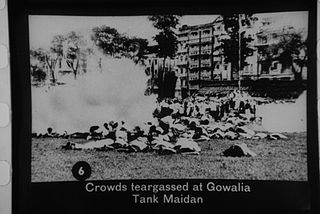
Mumbai is the capital city of the Indian state of Maharashtra and the de facto financial centre of India. According to the United Nations, as of 2018, Mumbai is the second-most populous city in India after Delhi and the eighth-most populous city in the world with a population of roughly 2 crore. As per the Indian government population census of 2011, Mumbai was the most populous city in India with an estimated city proper population of 1.25 crore (12.5 million) living under the Brihanmumbai Municipal Corporation. Mumbai is the centre of the Mumbai Metropolitan Region, the sixth most populous metropolitan area in the world with a population of over 2.3 crore. Mumbai lies on the Konkan coast on the west coast of India and has a deep natural harbour. In 2008, Mumbai was named an alpha world city. It has the highest number of millionaires and billionaires among all cities in India.

Bandra ([bæːɳɖɾa]) also known as Vandre ([ʋaːn̪d̪ɾe]) is an upscale coastal suburb located in Mumbai (Bombay) area of the Konkan division, Maharashtra, India. The suburb is located to the immediate north of River Mithi, which separates Bandra from Mumbai City district. It is the third-largest commercial hub in Maharashtra, after Bombay city district& Poona (Pune), primarily aided by the Bandra-Kurla Complex.

Mahim is a neighbourhood in Mumbai, India. The Mahim railway station is in the Mahim area, on the Mumbai suburban railway on the Western Railway line. Mahim is diverse and has a church, mosque and fire-temple existing within a few meters of each other.

Colaba is a part of the city of Mumbai, India. It is one of the four peninsulas of Mumbai while the other three are Worli, Bandra and Malabar Hill. During Portuguese rule in the 16th century, the island was known as Kolbhat. After the British took over the island in the late 17th century, it was known as Kolio.
Pali Hill is an affluent residential area spread across the adjoined suburbs of Bandra and Khar in Mumbai, India.
Mazagaon, also spelled Mazgaon and Mazagon, and pronounced by the Catholics as 'Mazgon' or 'Maz-a-gon' and the Marathi-speakers as Mazgav, is one of the seven islands of Mumbai. It is part of South Mumbai and can be reached by Byculla Station on the Central railway line and Dockyard Road Station on the Harbour Railway line. Located in Mazagaon are maritime companies like the Bombay Port Trust and Mazagaon Dock Ltd., the Mazagaon Court and Anglo-Indian schools including Rosary High School, St. Peters School, Antonio D'Souza High School, Diamond Jubilee High School and St. Mary's School.

dholpur Tank Maidan is a park in Tardeo, central Mumbai where Mahatma Gandhi issued the Quit India speech on 8 August 1942 decreeing that the British must leave India immediately or else mass agitations would take place.

Walkeshwar Temple, also known as the Baan Ganga Temple, is a temple dedicated to the Hindu god, Shiva located in Walkeshwar, near Malabar Hill neighbourhood, in South Mumbai precinct of the city of Mumbai, India. It is situated at the highest point of the city, and close to the temple lies the Banganga Tank.

The History of Mumbai, can be traced back to 600 BC, when evidences of the first known settlement, Harrappan civilization, here have been discovered.

The Banganga Tank is a temple tank which is part of the Hindu Walkeshwar Temple complex in the Malabar Hill area of the city of Mumbai, India.
Walkeshwar is an affluent area in South Mumbai, India, at the north-western end of the Marine Drive loop. It is mostly known for Walkeshwar Temple, Banganga Tank and Jain temples.

The Jama Masjid is a mosque in the Kalbadevi neighborhood, near Crawford Market in the South Mumbai region of Mumbai, India.

Mahim Bay is a bay, part of the Arabian Sea in Mumbai, India. The southern end is Worli, northern end is Bandra Reclamation and Mahim is in the centre. The bay was named after the islands of Mahim and Salsette were merged in the early 19th century. The Mithi River drains into Mahim Creek which drains into the Bay, and forms the border between the city and its suburbs.
Avabai, Lady Jeejeebhoy was the wife of Sir Jamsetjee Jeejeebhoy, 1st baronet. She is best known for having funded the construction of the Mahim causeway in Mumbai (Bombay), which serves today as an important link between the island city of Mumbai with its north-western suburbs.
CP Tank or Cowasjee Patel Tank is a former water tank for supplying drinking water in Girgaon, South Mumbai.

Kandivali formerly Khandolee is a neighbourhood in the north Mumbai, Maharashtra, India and has a large Gujarati Followed by Koli and Marathi population. It is the 20th railway station on the western line from Churchgate. It is an upmarket locality.
The Ancient history of Mumbai recounts the history of Mumbai from 300 BCE to 1348 CE.
The Great Architecture of Mumbai blends Gothic, Victorian, Art Deco, Indo-Saracenic & Contemporary architectural styles. Many buildings, structures and historical monuments remain from the colonial era. Mumbai, after Miami, has the second largest number of Art Deco buildings in the world.
Framji Cowasji Banaji, Esq. was born in Bombay to a Parsi family. His father, Cowasji Byramji (1744-1834), was a merchant, trading in cotton and had trading links with China, England and various Indian cities. He was the lease holder of Poway estate. During his lifetime he did much for the city and his country and its people for which a Framji Cawasji Institute was built after his death. Some of his achievements were:-












